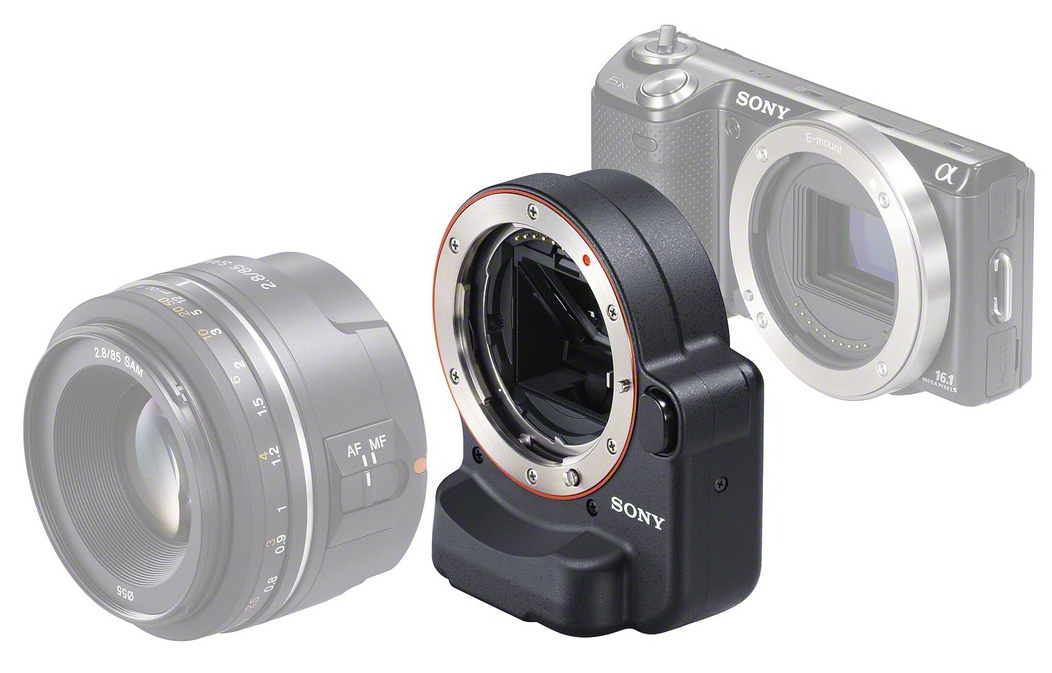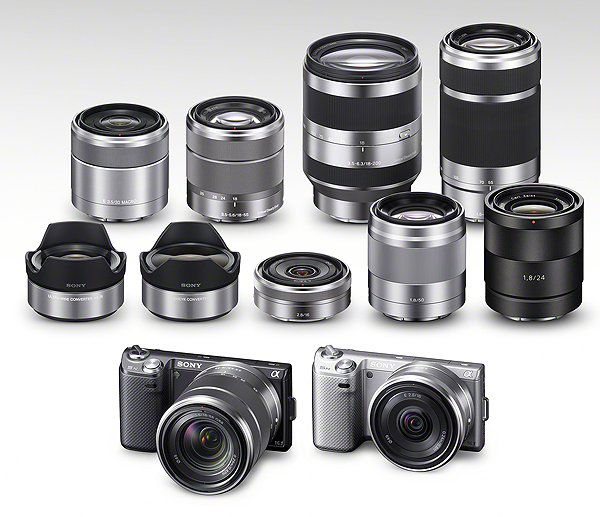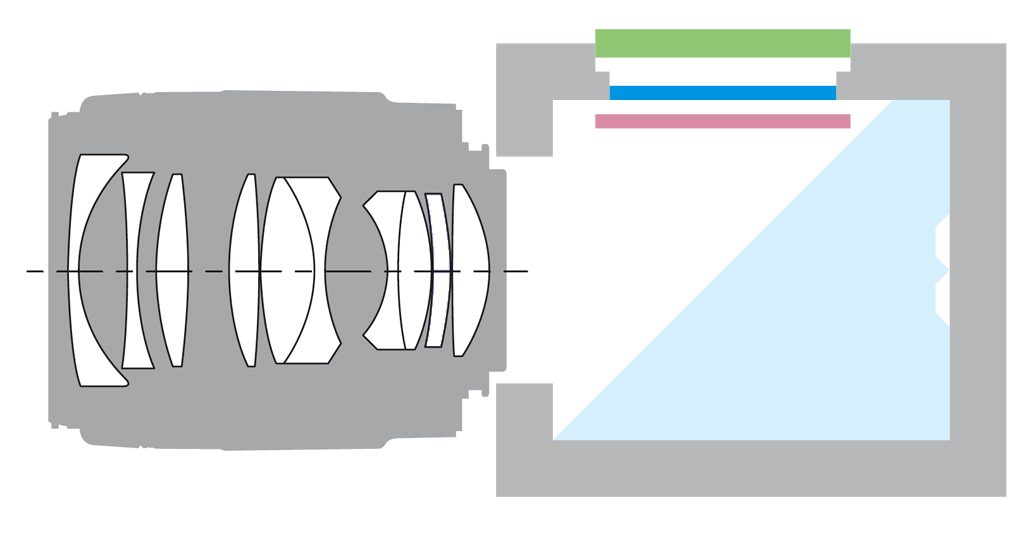All the predicted new models from Sony were unveiled today – the Alpha 77, Alpha 65, NEX-7, NEX-5n and NEX-VG20.
Full details are up on Sony’s websites. The A77/65 cameras will be on sale from October 2011 onwards. View Sony press information online.
Those who grab the cameras will find the virtual 1.09X 100% field of view given by the OLED finders looks to be visually 10% bigger than the largest APS-C viewfinders made, an experience close to using a full frame DSLR with an optical prism (1.09X at 23mm eyepoint).

The Alpha 77 is launched with the new 16-50mm f/2.8 SSM (not SAM as rumoured!) lens, and the Alpha 65 shares the same new 2.3 megapixel OLED viewfinder technology. The burst speed of the 77 is revealed to be 12 frames per second (predictions have ranged from 10 to 15) with the A65 achieving 10. The new 19-point, 11-cross point AF module is fitted to the A77 only, the A65 has a simpler 15-point, 3-cross module.
Both have the 24.3 megapixel CMOS sensor also found in the new NEX-7 model, but only the A77 allows ISO 50 capture (all allow 16,000). The A77 has a fully articulated 3-way swivelling rear screen and the A65 a simpler 2-directional hinge. HD video is upgraded to full 50/60 frames 1080 progressive (no longer 25/30p or 1080i) with full manual control.
The A77 has a semipro spec 1/8,000th shutter speeded to 1/250th for X sync, and rated for 150,000 cycles (tests will probably showe it uses a hybrid electronic/mechanical timing method to reduce shutter wear, but you’ll have to look elsewhere to confirm that, as we are not at the launch event). It has the expected GPS onboard.

The A65 is regular plastic-skin construction (see strap lugs, above) but the A77 is moisture/dust sealed and so, according to the information, are ther 16-50mm and the new HVL-F43AM flash and VG-C77AM vertical grip. The 77 uses full size NP-FM500H batteries.
Paul Genge, Technical Field Sales Manager for Sony UK, will be online for a one-hour live video Q&A session on the company’s Facebook page from 7.30pm GMT – visit www.facebook.com/SonyUK to partticipate.
Key points: auto ISO remains 100-1600 not expanded in range on the A65, but can be user set for 100-12,800 on the A77, which also has separately set 50 and 16,000 options plus a multishot 25,600 (the A65 also has this high speed mode). The A77 offers JPEG Extra Fine, the A65 does not.
The viewfinder magnification (eyepiece/screen combination) is not stated but is superior to the A55 with a half-inch OLED.
On the A77 only, exposure bracketing has been expanded to 3 frames at 2EV and 3EV intervals, in addition to 3 or 5 frames at 1/3, 1/2, or 2/3 EV; the A65 offers only 1/3 or 2/3 for 3 frames. Peculiarly, neither offers 1 EV bracketing.
The A77 or A65 normal motordrive with full AF/AE is 8fps (slow speed 3fps), the higher speeds are obtained with Continuous Advance Priority (fixed settings during burst). Both can achieve 13 raws, 17 fine JPEGs before slowing.
It doesn’t look as if either accepts the HVL-F58AM as a wireless controller, but both have built-in wireless. The rumour of CF card compatibility in the A77 was false, the cameras have dual MemoryStick PRO Duo/SD drives.

The NEX-7
The professional NEX has the 24.3 megapixel sensor, ultra-fast response with startup and focus time improvements, the same OLED viewfinder as the A77/65 built in to the body, the same full HD 1080/50/25p movie (Europe, 60/30 US) and the same sensitivity range as the A77. Manual refocusing is possible during video, 10fps bursts can be shot, and a leather case turns the camera into a Leica-like for eye level use.
The NEX-7 has the slower 1/4,000th with 1/160th sync shutter found in the A65 so it’s not all professionally-biased. And it’s got a small buffer, allowing a mere 6 raw frames or 4 raw+JPEG in a burst, 10 JPEGs at Fine res (no Extra Fine option is offered).
All the pre-existing bells and whistles remain included, such as Sweep Pan, 3D Pan, etc.
Please note: the OLED viewfinder on all these cameras is a power hog. With the NEX, for example, the rated battery life is 350 images using the finder, 430 images using the rear screen. The bigger battery of the A77 can still only power 470 shots (because of GPS?) where the A65 manages a respectable 510. Switching to the rear screen for composition increases these figures to 530 and 560.
There is NO new updated standard lens for the NEX and the existing 18-55mm will fight it out with the increased 24 megapixels!
No GPS. No info on potential GPS attachment.
View press info online.

The NEX-5n
The 16.1 megapixel sensor, also found in the new video VG20 model, gets into the updated NEX-5 which has the same improvements in response time and focusing as the 7 (claimed doubling of readout speed from the CD-AF system).
Its USP appears to be the ability to simulate a preview of adjustments on the screen and adjust them using touch control. It has 10fps burst.
There is a new EVF attachment. View press release online.

A new battery powered LE-EA2 adaptor which allows autofocus with ALL Alpha lenses including Minolta body-drive types back to 1985 is also to be available, above. It includes a downward-facing SLT pellicle mirror (don’t know why they did not use this design in regular cameras) and a Phase Detect AF module so the NEX can behave exactly like an Alpha 55. Note the screw drive focus coupling.

Looks like a decent lens-line-up, but me, I prefer more pancakes for my breakfast, not just a stack on one…
Along with the two new NEX models, the Carl Zeiss Sonnar T* E 24mm f/1.8, the Sony E 50mm f/1.8 OSS and the telephoto zoom E 55-210mm f/4.5-6.3 OSS are to be launched. Availability of the new NEX gear should be quick – from September for the 5n, November for the 7.
The NEX-VG20
Aye well, it’s 16 megapixel video formfactor model as per VG10. See the info online. It claims the best ever video from such a camera – but they say the same about the ‘still’ models and they are probably right.
Sorry about a few of Sony’s uncropped image files with loads of white round them, they always do this and we will crop them later. But I’m due 100 miles away for a major Associateship and Fellowship annual judging to see some good photography and I have already made myself late with this! The article will be revised tonight. – David





















